|
Infected Cell Protein 34.5
Infected cell protein 34.5 (ICP-34.5, ICP34.5, or GADD34) is a protein expressed by the γ34.5 gene in viruses such as herpes simplex virus; it blocks a cellular stress response to viral infection. It shares the C-terminal regulatory domain () with protein phosphatase 1 subunit 15A/ B. When a cell is infected with a virus, protein kinase R is activated by the virus' double-stranded DNA,. Protein kinase R then phosphorylates a protein called eukaryotic initiation factor-2A (eIF-2A), which inactivates eIF-2A. EIF-2A is required for translation so by shutting down eIF-2A, the cell prevents the virus from hijacking its own protein-making machinery. Viruses in turn evolved ICP34.5 to defeat the defense; it activates protein phosphatase-1A which dephosphorylates eIF-2A, allowing translation to occur again. A herpesvirus lacking the γ34.5 gene will not be able to replicate in normal cells because it cannot make proteins. The ICP34.5 deletion is useful for the construction of onco ... [...More Info...] [...Related Items...] OR: [Wikipedia] [Google] [Baidu] |
Herpes Simplex Virus
Herpes simplex virus 1 and 2 (HSV-1 and HSV-2), also known by their taxonomical names ''Human alphaherpesvirus 1'' and '' Human alphaherpesvirus 2'', are two members of the human ''Herpesviridae'' family, a set of viruses that produce viral infections in the majority of humans. Both HSV-1 and HSV-2 are very common and contagious. They can be spread when an infected person begins shedding the virus. As of 2016, about 67% of the world population under the age of 50 had HSV-1. In the United States, about 47.8% and 11.9% are estimated to have HSV-1 and HSV-2, respectively, though actual prevalence may be much higher. Because it can be transmitted through any intimate contact, it is one of the most common sexually transmitted infections. Symptoms Many of those who are infected ''never'' develop symptoms. Symptoms, when they occur, may include watery blisters in the skin or mucous membranes of the mouth, lips, nose, genitals, or eyes (herpes simplex keratitis). Lesions heal with a ... [...More Info...] [...Related Items...] OR: [Wikipedia] [Google] [Baidu] |
Cellular Stress Response
Cellular stress response is the wide range of molecular changes that cells undergo in response to environmental stressors, including extremes of temperature, exposure to toxins, and mechanical damage. Cellular stress responses can also be caused by some viral infections. The various processes involved in cellular stress responses serve the adaptive purpose of protecting a cell against unfavorable environmental conditions, both through short term mechanisms that minimize acute damage to the cell's overall integrity, and through longer term mechanisms which provide the cell a measure of resiliency against similar adverse conditions. General characteristics Cellular stress responses are primarily mediated through what are classified as ''stress proteins''. Stress proteins often are further subdivided into two general categories: those that only are activated by stress, or those that are involved both in stress responses and in normal cellular functioning. The essential character of ... [...More Info...] [...Related Items...] OR: [Wikipedia] [Google] [Baidu] |
PPP1R15A
Protein phosphatase 1 regulatory subunit 15A also known as growth arrest and DNA damage-inducible protein GADD34 is a protein that in humans is encoded by the ''PPP1R15A'' gene. The Gadd34/MyD116 gene was originally discovered as a member in a set of gadd and MyD mammalian genes encoding acidic proteins that synergistically suppress cell growth. Later on it has been characterized as a gene playing a role in ER stress-induced cell death, being a target of ATF4 that plays a role in ER-mediated cell death via promoting protein dephosphorylation of eIF2α and reversing translational inhibition. Function This gene is a member of a group of genes whose transcript levels are increased following stressful growth arrest conditions and treatment with DNA-damaging agents. The induction of this gene by ionizing radiation occurs in certain cell lines regardless of p53 status, and its protein response is correlated with apoptosis following ionizing radiation. Interactions PPP1R15A has bee ... [...More Info...] [...Related Items...] OR: [Wikipedia] [Google] [Baidu] |
Protein Kinase R
Protein kinase RNA-activated also known as protein kinase R (PKR), interferon-induced, double-stranded RNA-activated protein kinase, or eukaryotic translation initiation factor 2-alpha kinase 2 (EIF2AK2) is an enzyme that in humans is encoded by the ''EIF2AK2'' gene. PKR protects against viral infections. Mechanism of action Protein kinase-R is activated by double-stranded RNA (dsRNA), introduced to the cells by a viral infection. PKR can also be activated by the protein PACT or by heparin. PKR contains an N-terminal dsRNA binding domain (dsRBD) and a C-terminal kinase domain, that gives it pro-apoptotic (cell-killing) functions. The dsRBD consists of two tandem copies of a conserved double stranded RNA binding motif, dsRBM1 and dsRBM2. PKR is induced by interferon in a latent state. Binding to dsRNA is believed to activate PKR by inducing dimerization and subsequent auto-phosphorylation reactions. In situations of viral infection, the dsRNA created by viral replication and g ... [...More Info...] [...Related Items...] OR: [Wikipedia] [Google] [Baidu] |
Phosphorylation
In chemistry, phosphorylation is the attachment of a phosphate group to a molecule or an ion. This process and its inverse, dephosphorylation, are common in biology and could be driven by natural selection. Text was copied from this source, which is available under a Creative Commons Attribution 4.0 International License. Protein phosphorylation often activates (or deactivates) many enzymes. Glucose Phosphorylation of sugars is often the first stage in their catabolism. Phosphorylation allows cells to accumulate sugars because the phosphate group prevents the molecules from diffusing back across their transporter. Phosphorylation of glucose is a key reaction in sugar metabolism. The chemical equation for the conversion of D-glucose to D-glucose-6-phosphate in the first step of glycolysis is given by :D-glucose + ATP → D-glucose-6-phosphate + ADP : ΔG° = −16.7 kJ/mol (° indicates measurement at standard condition) Hepatic cells are freely permeable to glucose, and ... [...More Info...] [...Related Items...] OR: [Wikipedia] [Google] [Baidu] |
EIF2
Eukaryotic Initiation Factor 2 (eIF2) is an eukaryotic initiation factor. It is required for most forms of eukaryotic translation initiation. eIF2 mediates the binding of tRNAiMet to the ribosome in a GTP-dependent manner. eIF2 is a heterotrimer consisting of an alpha (also called subunit 1, EIF2S1), a beta (subunit 2, EIF2S2), and a gamma (subunit 3, EIF2S3) subunit. Once the initiation phase has completed, eIF2 is released from the ribosome bound to GDP as an inactive binary complex. To participate in another round of translation initiation, this GDP must be exchanged for GTP. Function eIF2 is an essential factor for protein synthesis that forms a ternary complex (TC) with GTP and the initiator Met-tRNAiMet. After its formation, the TC binds the 40S ribosomal subunit to form the 43S preinitiation complex (43S PIC). 43S PIC assembly is believed to be stimulated by the initiation factors eIF1, eIF1A, and the eIF3 complex according to ''in vitro'' experiments. The 43S PIC then ... [...More Info...] [...Related Items...] OR: [Wikipedia] [Google] [Baidu] |
Translation (biology)
In molecular biology and genetics, translation is the process in which ribosomes in the cytoplasm or endoplasmic reticulum synthesize proteins after the process of transcription (biology), transcription of DNA to RNA in the cell's nucleus (cell), nucleus. The entire process is called gene expression. In translation, mRNA, messenger RNA (mRNA) is decoded in a ribosome, outside the nucleus, to produce a specific amino acid chain, or polypeptide. The polypeptide later protein folding, folds into an Activation energy, active protein and performs its functions in the Cell (biology), cell. The ribosome facilitates decoding by inducing the binding of Base pair, complementary tRNA anticodon sequences to mRNA codons. The tRNAs carry specific amino acids that are chained together into a polypeptide as the mRNA passes through and is "read" by the ribosome. Translation proceeds in three phases: # Initiation: The ribosome assembles around the target mRNA. The first tRNA is attached a ... [...More Info...] [...Related Items...] OR: [Wikipedia] [Google] [Baidu] |
Protein Phosphatase 1
Protein phosphatase 1 (PP1) belongs to a certain class of phosphatases known as protein serine/threonine phosphatases. This type of phosphatase includes metal-dependent protein phosphatases (PPMs) and aspartate-based phosphatases. PP1 has been found to be important in the control of glycogen metabolism, muscle contraction, cell progression, neuronal activities, splicing of RNA, mitosis, cell division, apoptosis, protein synthesis, and regulation of membrane receptors and channels. Structure Each PP1 enzyme contains both a catalytic subunit and at least one regulatory subunit. The catalytic subunit consists of a 30-kD single-domain protein that can form complexes with other regulatory subunits. The catalytic subunit is highly conserved among all eukaryotes, thus suggesting a common catalytic mechanism. The catalytic subunit can form complexes with various regulatory subunits. These regulatory subunits play an important role in substrate specificity as well as compartmentalizatio ... [...More Info...] [...Related Items...] OR: [Wikipedia] [Google] [Baidu] |
Oncolytic Herpes Virus
Many variants of herpes simplex virus have been considered for viral therapy of cancer; the early development of these was thoroughly reviewed in the journal ''Cancer Gene Therapy'' in 2002. This page describes (in the order of development) the most notable variants—those tested in clinical trials: G207, HSV1716, NV1020 and Talimogene laherparepvec (previously Oncovex-GMCSF). These attenuated versions are constructed by deleting viral genes required for infecting or replicating inside normal cells but not cancer cells, such as ICP34.5, ICP6/UL39, and ICP47. HSV1716 HSV1716 is a first generation oncolytic virus developed by The Institute of Virology, Glasgow, UK, and subsequently by Virttu Biologics (formerly Crusade Laboratories, a spin-out from The Institute of Virology), to selectively destroy cancer cells. The virus has the trade name SEPREHVIR. It is based on the herpes simplex virus (HSV-1). The HSV1716 strain has a deletion of the gene ICP34.5. ICP34.5 is a neurovir ... [...More Info...] [...Related Items...] OR: [Wikipedia] [Google] [Baidu] |
Viral Nonstructural Protein
In virology, a nonstructural protein is a protein encoded by a virus but that is not part of the viral particle. They typically include the various enzymes and transcription factors the virus uses to replicate itself, such as a viral protease ( 3CL/nsp5, etc.), an RNA replicase or other template-directed polymerases, and some means to control the host. Examples * NSP1 (rotavirus) * NSP4 (rotavirus) * NSP5 (rotavirus) * Influenza non-structural protein * NS1 influenza protein * HBcAg, core antigen of hepatitis B *Bunyaviridae nonstructural S proteins See also * Viral structural protein A viral structural protein is a viral protein that is a structural component of the mature virus. Examples include the SARS coronavirus 3a and 7a accessory proteins. Bacteriophage T4 structural proteins During assembly of the bacteriophage (pha ... References {{protein-stub ... [...More Info...] [...Related Items...] OR: [Wikipedia] [Google] [Baidu] |

_CROPPED.jpg)


